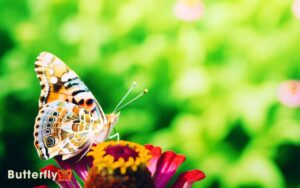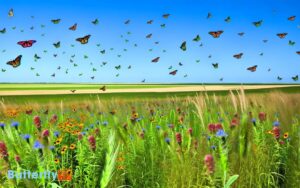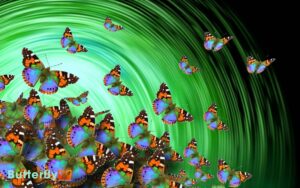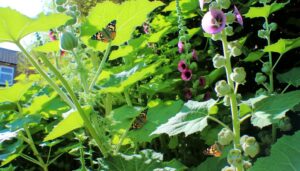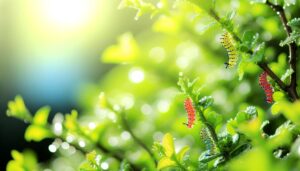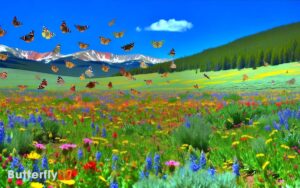American Painted Lady Butterflies Kentucky: Essential Guide!
The American Painted Lady (Vanessa virginiensis) flourishes in Kentucky’s open fields, meadows, and urban gardens. Distinguishable by its orange and black wings with white spots and blue eyespots, it’s part of the Nymphalidae family.
Conservation efforts in Kentucky focus on habitat preservation and creating pollinator corridors. Learn about their migration patterns and conservation practices to support their thriving populations.
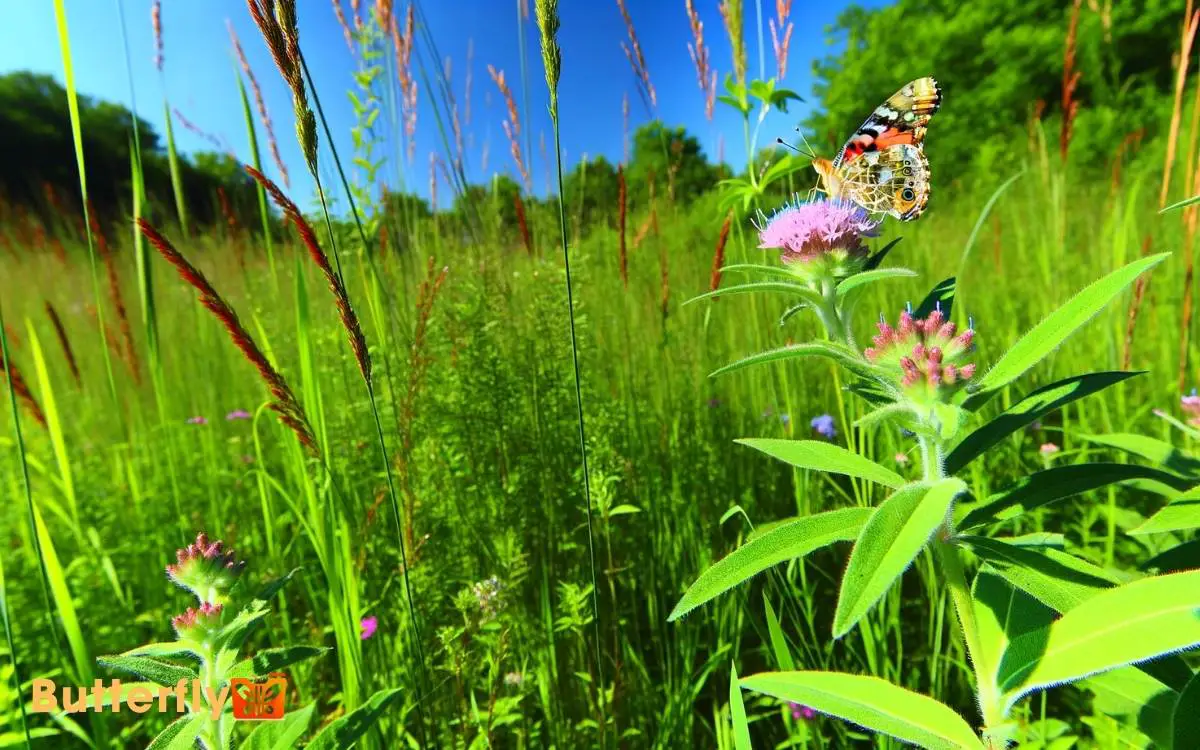
Key Takeaways
Identification and Appearance
The American Painted Lady butterfly, Vanessa virginiensis, is frequently identified by its distinctive orange and black patterned wings, adorned with white spots and a significant row of blue eyespots on the hindwings.
The forewings exhibit a complex interplay of black and orange, with white patches near the apex. The underside of the wings presents a more cryptic appearance, blending browns and grays, which aids in camouflage.
This species’ eyespots serve both as a deterrent to predators and a means of identification among lepidopterists. Additionally, the butterfly’s antennae are clubbed, typical of the Nymphalidae family.
These morphological traits are essential for distinguishing Vanessa virginiensis from similar species, such as the Painted Lady, Vanessa cardui.
Life Cycle Stages
American Painted Lady butterflies undergo four distinct life cycle stages: egg, larva, pupa, and adult. The female lays her eggs singly on host plants.
Larvae, or caterpillars, hatch within 5-7 days, sporting black spines and feeding voraciously on foliage. This larval stage lasts about 2-3 weeks, during which the caterpillar undergoes several molts.
Upon reaching full size, the larva forms a chrysalis, entering the pupal stage. This transformative phase lasts approximately 10 days, during which metamorphosis occurs.
Emerging as adults, these butterflies exhibit vibrant coloration with orange, black, and white patterns. Adults live for about two weeks, during which they focus on feeding and reproduction, completing the cycle.
Preferred Habitats
Preferring diverse environments, American Painted Lady butterflies thrive in open fields, gardens, and meadows where host plants like asters and thistles are abundant.
These habitats provide essential resources for their lifecycle, including nectar sources and suitable sites for oviposition.
The species, Vanessa virginiensis, exhibits a broad ecological tolerance, adapting to both rural and urban landscapes.
In Kentucky, they frequent areas with ample sunlight and minimal canopy cover, which supports their thermoregulatory needs. The presence of larval host plants, primarily members of the Asteraceae family, is vital for their reproduction.
These butterflies also utilize disturbed habitats, such as roadsides and vacant lots, demonstrating their resilience. Their habitat preference reflects a balance between resource availability and environmental conditions.
Feeding and Behavior
The American Painted Lady butterfly, Vanessa virginiensis, exhibits specific feeding behaviors, favoring nectar from a variety of flowering plants such as asters and thistles.
Its flight pattern is characterized by rapid, erratic movements, which aid in evading predators.
During feeding, the butterfly uses its proboscis to extract nectar, displaying a preference for brightly colored and fragrant blooms.
Nectar Sources Preferences
Many American Painted Lady butterflies exhibit a strong preference for nectar sources like asters, goldenrods, and milkweeds, which provide essential nutrients for their survival and reproduction.
These butterflies, scientifically known as Vanessa virginiensis, show selective feeding behavior based on floral availability and nectar composition.
Key preferences include:
- Asters (Asteraceae family): Rich in nectar, these flowers attract many pollinators including the American Painted Lady.
- Goldenrods (Solidago spp.): These plants bloom late in the season, offering a crucial nectar source when other flowers are scarce.
- Milkweeds (Asclepias spp.): Known for their high nectar content, milkweeds support diverse butterfly species.
Understanding these preferences aids in habitat conservation efforts, ensuring the availability of critical nectar sources.
Flight and Feeding Patterns
Observation of American Painted Lady butterflies reveals intricate flight patterns and adaptive feeding behaviors that optimize their energy efficiency and survival. These butterflies exhibit a characteristic erratic yet purposeful flight, allowing them to evade predators.
Their feeding behaviors are equally vital; they prefer nectar from flowers such as asters, thistles, and clover. This diet is essential for maintaining their vibrant coloration and reproductive capabilities.
| Behavior | Description | Emotional Impact |
|---|---|---|
| Flight | Erratic yet purposeful | Awe at their agility |
| Nectar Feeding | Preference for asters, thistles, clover | Delight in their choices |
| Predator Evasion | Quick, unpredictable movements | Admiration for their survival skills |
Such behaviors highlight the American Painted Lady’s adaptability and the delicate balance it maintains within its ecosystem.
Host Plants in Kentucky
The American Painted Lady butterfly (Vanessa virginiensis) primarily utilizes host plants belonging to the Asteraceae family, such as the pearly everlasting (Anaphalis margaritacea) and the cudweeds (Gnaphalium spp.).
These butterflies prefer habitats where these native plants thrive, including open fields and meadows.
The presence of native plants not only supports the larvae’s growth but also enhances local biodiversity.
Common Host Plants
Kentucky’s diverse flora provides essential host plants for the American Painted Lady butterfly, particularly species in the Asteraceae family such as Antennaria plantaginifolia (plantain-leaved pussytoes) and Gnaphalium obtusifolium (sweet everlasting).
These plants offer critical resources for larvae development and are crucial for the butterfly’s life cycle.
Key host plants include:
- Antennaria plantaginifolia: Known for its broad, basal leaves, it supports larval growth and is commonly found in open woodlands.
- Gnaphalium obtusifolium: This plant, with its aromatic foliage, provides a suitable environment for larvae and thrives in disturbed soils.
- Anaphalis margaritacea: Also called pearly everlasting, it’s favored for its dense, woolly stems and leaves, offering protection and nourishment to the larvae.
These plants secure the butterfly’s survival and proliferation in Kentucky.
Preferred Plant Habitats
Identifying the preferred habitats of host plants for the American Painted Lady butterfly in Kentucky involves examining areas such as open woodlands, meadows, and disturbed soils where these essential flora thrive.
These butterflies favor locations rich in Asteraceae family members like cudweed (Gnaphalium spp.) and pussytoes (Antennaria spp.). They also frequent fields and roadsides where burdock (Arctium spp.) and plantain (Plantago spp.) grow.
Understanding these habitats is vital for conservation efforts and ensuring a sustainable environment for these butterflies.
| Habitat Type | Representative Plants | Environmental Conditions |
|---|---|---|
| Open Woodlands | Gnaphalium spp. | Partial shade, well-drained |
| Meadows | Antennaria spp. | Full sun, moderate moisture |
| Disturbed Soils | Arctium spp., Plantago spp. | Full sun, varied soil types |
These habitats provide the necessary resources for the American Painted Lady’s lifecycle.
Native Plant Benefits
Among the myriad benefits of native host plants in Kentucky, their role in providing essential nutrients and habitat for the American Painted Lady butterfly (Vanessa virginiensis) stands paramount.
These butterflies rely on specific host plants for larval development, ensuring their survival and propagation.
Key native host plants in Kentucky include:
- Antennaria plantaginifolia (Pussytoes): This plant supports larval feeding, providing necessary nutrients.
- Gnaphalium obtusifolium (Sweet Everlasting): Offers a prime location for egg-laying and larval growth.
- Anaphalis margaritacea (Pearly Everlasting): Serves as both a food source and habitat for larvae.
Migration Patterns
The American Painted Lady butterflies exhibit intricate migration patterns that involve seasonal movements between their breeding grounds in the northern United States and overwintering sites in the southern regions. These migrations are influenced by temperature changes and the availability of nectar sources, ensuring their survival throughout the year. Researchers have observed that painted lady butterflies in Iowa are particularly abundant during the late summer months as they travel southward. Their journey highlights the remarkable adaptability of this species to varying environmental conditions.
These butterflies, scientifically known as Vanessa virginiensis, undertake this journey to exploit favorable climatic conditions and abundant food sources.
In spring, they migrate northward, taking advantage of blooming flora for oviposition. As autumn approaches, they travel southward to escape the impending cold.
This migration isn’t a single-generation endeavor; multiple generations are involved, with each cohort advancing the journey.
Researchers have noted that their migration is influenced by factors such as temperature, photoperiod, and wind patterns. These variables play an essential role in their successful navigation and survival during the migration process.
Conservation Efforts
In light of declining populations, conservation efforts for the American Painted Lady, Vanessa virginiensis, focus on habitat preservation and the establishment of butterfly corridors to secure their migratory success.
Key strategies include:
- Habitat Restoration: Implementing native plantings and removing invasive species to create suitable environments for breeding and feeding.
- Pollinator Corridors: Establishing continuous habitats that facilitate safe passage during migrations, ensuring access to nectar sources.
- Public Education: Raising awareness about the ecological importance of butterflies and promoting community involvement in conservation efforts.
These measures aim to bolster population numbers by addressing environmental pressures and enhancing the quality of available habitats. Scientists and conservationists emphasize the importance of integrated efforts to create sustainable ecosystems for Vanessa virginiensis.
Butterfly Gardening Tips
Creating a butterfly-friendly garden involves selecting native plants that provide nectar and host resources essential for the American Painted Lady‘s lifecycle. Vanessa virginiensis thrives on a variety of flora.
Nectar sources like asters (Asteraceae) and milkweed (Asclepias) are vital, while host plants such as cudweed (Gnaphalium) support larval development.
Gardeners should plant these species in sunny areas, ensuring a continuous bloom cycle. Avoiding pesticides is crucial to maintain a healthy habitat. Incorporating shallow water sources and rocks for sunning can also enhance the environment.
Conclusion
In the kaleidoscope of Kentucky’s natural beauty, the American painted lady butterfly flutters as a vivid brushstroke. Its life cycle, from egg to vibrant adult, unfolds like a meticulously crafted symphony.
Preferring sunny meadows and gardens, it dances on nectar-laden breezes, sustained by native host plants. As it migrates, this delicate traveler weaves through ecosystems, reminding us of nature’s intricate web.
Conservation and mindful gardening are the keys to ensuring these winged jewels continue to grace our landscapes.

